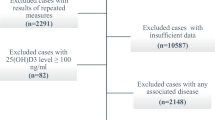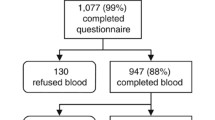Abstract
Purpose
To examine the prevalence and determinants of vitamin D deficiency in Iranian children and adolescents.
Methods
We used data from a national school-based surveillance program conducted among 7-18-year-old children and adolescents living in rural and urban areas in 30 provinces of Iran. Data on student’s lifestyle, health behaviors, and health status was obtained through a validated questionnaire. Serum 25-hydroxy vitamin D (25-OH-D) level was measured by chemiluminescent immunoassay. Vitamin D deficiency was defined as serum 25-OH-D concentrations < 30 ng/ml. Determinants of vitamin D deficiency were identified using logistic regression analysis.
Results
Data of 2,596 participants were available for this study. Prevalence of vitamin D deficiency was 71.1 % (95 % Confidence interval (CI): 69.3–72.8 %), without significant difference between boys and girls (72.0 % vs. 70.1 %, respectively, p = 0.29). In the multivariate regression model, in both genders, those who reported having sun exposure for at least 30 min/day and those taking vitamin D supplementation had lower odds for vitamin D deficiency (all p values < 0.05). In boys, obesity increased the odds of vitamin D deficiency (adjusted OR, 95 % CI: 1.57, 1.08–2.27). The association of vitamin D deficiency with other demographic characteristics and food items was not statistically significant.
Conclusions
This large population-based study revealed a high frequency of hypovitaminosis D in Iranian children and adolescents. Sun exposure for at least 30 min/day and taking vitamin D supplementation may reduce the risk of vitamin D deficiency.
Similar content being viewed by others
Data Availability
All the data supporting the findings is contained within the manuscript.
References
Lips P. Vitamin D physiology. Prog Biophys Mol Biol. 2006;92(1):4–8.
Hossein-nezhad A, Holick MF (eds). Vitamin D for health: a global perspective. Mayo clinic proceedings. Amsterdam: Elsevier; 2013.
Weaver CM. Adolescence. Endocrine. 2002;17(1):43–8.
Afzal S, Brøndum-Jacobsen P, Bojesen SE, Nordestgaard BG. Vitamin D concentration, obesity, and risk of diabetes: a mendelian randomisation study. Lancet Diabetes Endocrinol. 2014;2(4):298–306.
Holick MF. Sunlight and vitamin D for bone health and prevention of autoimmune diseases, cancers, and cardiovascular disease. Am J Clin Nutr. 2004;80(6):1678S-88S.
Holick MF. The vitamin D deficiency pandemic: approaches for diagnosis, treatment and prevention. Rev Endocr Metab Disord. 2017;18(2):153–65.
Palacios C, Gonzalez L. Is vitamin D deficiency a major global public health problem? J Steroid Biochem Mol Biol. 2014;144:138–45.
Jazayeri M, Moradi Y, Rasti A, Nakhjavani M, Kamali M, Baradaran HR. Prevalence of vitamin D deficiency in healthy Iranian children: A systematic review and meta-analysis. Med J Islam Repub Iran. 2018;32:83.
Kelishadi R, Ardalan G, Gheiratmand R, Gouya MM, Razaghi EM, Delavari A, et al. Association of physical activity and dietary behaviours in relation to the body mass index in a national sample of Iranian children and adolescents: CASPIAN Study. Bull World Health Organ. 2007;85:19–26.
Motlagh ME, Ziaodini H, Qorbani M, Taheri M, Aminaei T, Goodarzi A, et al. Methodology and early findings of the fifth survey of childhood and adolescence surveillance and prevention of adult noncommunicable disease: The CASPIAN-V study. Int J Prev Med. 2017;8.
Ataie-Jafari A, Rahmat AB, Abbasi F, Loke SC, Qorbani M, Larijani B. Vitamin D status and associated factors in recent-onset type 1 diabetic children in Iran. J Diabetes Metab Disord. 2012;11(1):1–6.
Kelishadi R, Qorbani M, Djalalinia S, Sheidaei A, Rezaei F, Arefirad T, et al. Physical inactivity and associated factors in Iranian children and adolescents: the Weight Disorders Survey of the CASPIAN-IV study. J Cardiovasc Thorac Res. 2017;9(1):41.
Caro DH, Cortés D. Measuring family socioeconomic status: An illustration using data from PIRLS 2006. IERI Monograph Series Issues and Methodologies in Large-Scale Assessments. 2012;5:9–33.
Saggese G, Vierucci F, Boot AM, Czech-Kowalska J, Weber G, Camargo CA, et al. Vitamin D in childhood and adolescence: an expert position statement. Eur J Pediatrics. 2015;174(5):565–76.
Lam TP, Yip BHK, Lee WY, Tang NLS, Lee KM, Hung ALH, et al. Vitamin D among children in Asia. Nutritional influences on bone health. Berlin: Springer; 2019. p. 25–33.
Rossini M, Bongi SM, La Montagna G, Minisola G, Malavolta N, Bernini L, et al. Vitamin D deficiency in rheumatoid arthritis: prevalence, determinants and associations with disease activity and disability. Arthritis Res Ther. 2010;12(6):R216.
Mithal A, Wahl DA, Bonjour J-P, Burckhardt P, Dawson-Hughes B, Eisman JA, et al. Global vitamin D status and determinants of hypovitaminosis D. Osteoporos Int. 2009;20(11):1807–20.
Stagi S, Pelosi P, Strano M, Poggi G, Manoni C, de Martino M, et al. Determinants of vitamin D levels in Italian children and adolescents: a longitudinal evaluation of cholecalciferol supplementation versus the improvement of factors influencing 25 (OH) D status. Int J Endocrinol. 2014;2014.
Maguire JL, Birken CS, Khovratovich M, DeGroot J, Carsley S, Thorpe KE, et al. Modifiable determinants of serum 25-hydroxyvitamin D status in early childhood: opportunities for prevention. JAMA Pediatrics. 2013;167(3):230–5.
Chakhtoura M, El Ghandour S, Shawwa K, Akl EA, Arabi A, Mahfoud Z, et al. Vitamin D replacement in children, adolescents and pregnant women in the Middle East and North Africa: a systematic review and meta-analysis of randomized controlled trials. Metabolism. 2017;70:160–76.
Pereira-Santos M, Costa PRdF, Assis A, Santos CAdST. Santos DBd. Obesity and vitamin D deficiency: a systematic review and meta‐analysis. Obes Rev. 2015;16(4):341–9.
Pourshahidi LK. Vitamin D and obesity: current perspectives and future directions. Proc Nutri Soc. 2015;74(2):115–24.
Vanlint S. Vitamin D and obesity. Nutrients. 2013;5(3):949–56.
Kumar J, Muntner P, Kaskel FJ, Hailpern SM, Melamed ML. Prevalence and associations of 25-hydroxyvitamin D deficiency in US children: NHANES 2001–2004. Pediatrics. 2009;124(3):e362-e70.
Lehmann U, Gjessing HR, Hirche F, Mueller-Belecke A, Gudbrandsen OA, Ueland PM, et al. Efficacy of fish intake on vitamin D status: a meta-analysis of randomized controlled trials. Am J Clin Nutr. 2015;102(4):837–47.
Holick MF. Vitamin D deficiency. N Engl J Med. 2007;357(3):266–81.
Yetley EA. Assessing the vitamin D status of the US population. Am J Clin Nutr. 2008;88(2):558S-64S.
Acknowledgements
The authors would like to thank all participants who contributed to this nationwide project. This study was conducted as part of a national surveillance program and was funded by the National Institute for Medical Research Development (Code: 962514).
Funding
This study was conducted as part of a national surveillance program and was funded by the National Institute for Medical Research Development (Code: 962514).
Author information
Authors and Affiliations
Contributions
Design: Mostafa Qorbani, Ramin Heshmat, Roya Kelishadi, Mohammad Esmaeil Motlagh.
Study conduct: Mostafa Qorbani, Ramin Heshmat, Roya Kelishadi, Mohammad Esmaeil Motlagh.
Statistical analysis: Mostafa Qorbani, Hadith Rastad.
Paper drafting: Mostafa Qorbani, Hadith Rastad, Hamid Asayesh, Ehsan Seif.
All authors have contributed to revising the manuscript, confirmed the final draft for submission, and accepted the manuscript content’s responsibility.
Corresponding authors
Ethics declarations
Ethics approval and consent to participate
The study was conducted according to the Declaration of Helsinki (Seoul, 2008). Ethical approval was given by the Isfahan University of Medical Sciences ethics committee and other relevant national and provincial regulatory organizations. After a complete explanation of the objectives and protocols, each participant was assured that his/her responses would remain anonymous and confidential. Participation was voluntary, and all potential participants had the right to withdraw from the study at any time. Written informed consent and oral assent were obtained from the parents and students, respectively.
Consent for publication
Not applicable.
Conflict of interest
The authors declare that they have no competing interests.
Additional information
Publisher’s note
Springer Nature remains neutral with regard to jurisdictional claims in published maps and institutional affiliations.
Rights and permissions
About this article
Cite this article
Rastad, H., Mahdavi Gorabi, A., Qorbani, M. et al. Prevalence and determinants of vitamin D deficiency in Iranian children and adolescents: the CASPIAN-V study. J Diabetes Metab Disord 20, 383–389 (2021). https://doi.org/10.1007/s40200-021-00757-8
Received:
Revised:
Accepted:
Published:
Issue Date:
DOI: https://doi.org/10.1007/s40200-021-00757-8




